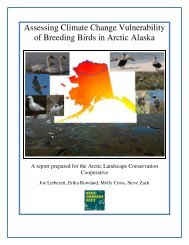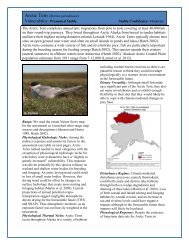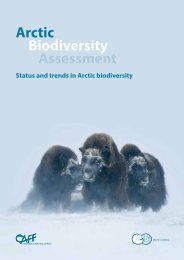Permafrost Terrain Stability and Thermokarst Monitoring: - Arctic LCC
Permafrost Terrain Stability and Thermokarst Monitoring: - Arctic LCC
Permafrost Terrain Stability and Thermokarst Monitoring: - Arctic LCC
You also want an ePaper? Increase the reach of your titles
YUMPU automatically turns print PDFs into web optimized ePapers that Google loves.
38. Frohn, R.C., Hinkel, K.M., <strong>and</strong> Eisner, W.R., 2005, Satellite remote sensing<br />
classification of thaw lakes <strong>and</strong> drained thaw-lake basins on the North Slope of Alaska:<br />
Remote Sensing of Environment, v. 97, no. 1, p. 116–126.<br />
This paper demonstrates a technique for mapping thermokarst lakes <strong>and</strong> drained lake basins<br />
on the North Slope of Alaska using L<strong>and</strong>sat satellite imagery <strong>and</strong> an object-oriented<br />
classification algorithm. Classification accuracy for identifying lakes <strong>and</strong> basins was greater<br />
than 93 percent. The end result was a map showing that the western <strong>Arctic</strong> Coastal Plain was<br />
covered with 20 percent lakes <strong>and</strong> 25 percent drained basins.<br />
39. Gooseff, M.N., Balser, A., Bowden, W.B., <strong>and</strong> Jones, J.B., 2009, Effects of hillslope<br />
thermokarst in northern Alaska: Eos, Transactions American Geophysical Union,<br />
v. 90, no. 4, p. 29–36.<br />
This paper describes the possible physical, chemical, <strong>and</strong> biological changes as a result of<br />
hillslope thermokarst in areas of continuous <strong>and</strong> discontinuous permafrost. Possible changes<br />
include increased sediment <strong>and</strong> nutrient loading into streams <strong>and</strong> rivers <strong>and</strong> changes in<br />
vegetation composition near affected areas. Hillslope thermokarst, or thawing of permafrost<br />
on hillslopes, results in the failure <strong>and</strong> mass wasting (downslope movement) of overlying<br />
soil <strong>and</strong> vegetation. Recent hillslope features observed include active layer detachments,<br />
thermokarst gullies, <strong>and</strong> retrogressive thaw slumps. Hillslope thermokarst events are<br />
increasing, <strong>and</strong> remote sensing <strong>and</strong> aerial photographs suggest that, in some areas of the<br />
<strong>Arctic</strong> Coastal Plain, a greater than 200-percent increase in hillslope permafrost failures has<br />
occurred since the 1980s.<br />
40. Grenier, C., Régnier, D., Mouche, E., Benabderrahmane, H., Costard, F., <strong>and</strong> Davy, P.,<br />
2013, Impact of permafrost development on groundwater flow patterns—A numerical<br />
study considering freezing cycles on a two-dimensional vertical cut through a generic<br />
river-plain system: Hydrogeology Journal, v. 21, no. 1, p. 257–270.<br />
This paper used a coupled water <strong>and</strong> heat flux model to consider the importance of advective<br />
flux to talik closure associated with a future glacial maximum. The study concerns a deep,<br />
alluvial basin in Europe, <strong>and</strong> shows that advective transport of heat through the subsurface<br />
prevents talik closure. This may be applicable to several settings on the <strong>Arctic</strong> Coastal Plain,<br />
including near-stream environments, deep connections between thaw lakes, <strong>and</strong>, sometime<br />
in the future, the duration of subsurface connections through an open talik network.<br />
41. Grosse, G., Harden, J., Turetsky, M., McGuire, A.D., Camill, P., Tarnocai, C.,<br />
Frolking, S., Schuur, E.A.G., Jorgenson, M.T., Marchenko, S., Romanovsky, V.E.,<br />
Wickl<strong>and</strong>, K.P., French, N., Waldrop, M., Bourgeau-Chavez, L., <strong>and</strong> Striegl, R.G.,<br />
2011, Vulnerability of high-latitude soil organic carbon in North America to<br />
disturbance: Journal of Geophysical Research, v. 116, no. G4, G00K06.<br />
Although the authors focus on the vulnerability of soil organic carbon, important<br />
thermokarst <strong>and</strong> thermo-erosion processes are summarized <strong>and</strong> their effects on soils <strong>and</strong><br />
ecosystem characteristics are described. The authors quantify areas of 73,000 km 2 <strong>and</strong><br />
814,000 km 2 with Cryosols underlain by ice-rich permafrost in Alaska <strong>and</strong> Canada,<br />
respectively. Pulse disturbances affecting soils as rapid processes such as thermokarst,<br />
thermo-erosion, <strong>and</strong> wildfires are defined <strong>and</strong> differentiated from press disturbances<br />
representing more gradual changes such as slow active layer deepening or changes in soil<br />
wetness. Approaches for predicting soil <strong>and</strong> soil carbon changes owing to such disturbances<br />
are shown <strong>and</strong> research <strong>and</strong> data gaps also are highlighted.<br />
16








